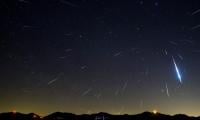US drone strikes surge in NWA despite military operation
ISLAMABAD: Saturday’s American unmanned spy plane’s strike in Shawal forested area of North Waziristan in which at least nine Afghan Taliban were reported to have been killed and numerous injured points to the sudden rise in frequency of hitting militants holed up in thick forested area where the Pakistan Air
By Ahmad Hassan
June 08, 2015
ISLAMABAD: Saturday’s American unmanned spy plane’s strike in Shawal forested area of North Waziristan in which at least nine Afghan Taliban were reported to have been killed and numerous injured points to the sudden rise in frequency of hitting militants holed up in thick forested area where the Pakistan Air Force has undertaken a number of air strikes but ground forces have not entered so far.
The report about Afghan Taliban’s killing in drone strike is not confirmed by any independent agency as the US has mentioned it whereas Pakistan has condemned it as usual ritual. The troops were scheduled to carry out ground offensive to flush out remnants of the militancy and clear the area most of which has already been achieved. Second aspect of this strike is that the drone strike has hit Afghan Taliban holed up in the area along with the TTP remnants. It was second drone strike within five days in the current month as first strike occurred on June 2. Two drone attacks were reported in May and one each was reported in March and April in the same vicinity.
It is however a matter of concern that the Afghan Taliban were hiding along with the TTP militants for those who are hoping that the year-long military Operation Zarb-e-Azb has cleared most of the NWA from the militant groups and either killed or forced them to flee the area and the return of the around one million internally displaced tribesmen has already begun. Another concern is for those who were thinking that use of US drones against TTP leaders would cease after its combat forces had left Afghanistan and its mission was over. An expert on Pakistan-Afghanistan situation said that such drone strikes tend to show that the US, despite having left the region militarily, was not ready to give up hitting militancy.
Prime Minister Nawaz Sharif and Afghan President Ashraf Ghani had agreed during the former’s Kabul sojourn last month that both countries will hit to eliminate wherever Afghan Taliban or TTP militants were found. Later, Pakistan’s premier intelligence agency ISI and Afghan intelligence agency had reached an understanding to cooperate in tracking down each other’s fugitive terrorists.
And in a surprise move, Dr Ghani wrote to the PM and other high ups in Islamabad last week to nab and take into custody all the Afghan Taliban and Haqqani group leaders that were stationed or operating from Pakistan’s soil. A response to that letter from Pakistan side has not been given so far. However, Islamabad’s position is clear that while it seeks Afghan intelligence and security forces cooperation in nabbing TTP chief Mullah Fazlullah, no stone would be left unturned if any Afghan Taliban leader was found in Pakistan. It has generally been perceived that the US drones fire missile only on intelligence reports which come through both CIA and Pakistani security agencies but the government of Pakistan has always opposed these strikes describing them as counterproductive. The drone strikes had been reported to have cut to half between December last year to March this year but the campaign seems to have been resumed with added ferocity.
The report about Afghan Taliban’s killing in drone strike is not confirmed by any independent agency as the US has mentioned it whereas Pakistan has condemned it as usual ritual. The troops were scheduled to carry out ground offensive to flush out remnants of the militancy and clear the area most of which has already been achieved. Second aspect of this strike is that the drone strike has hit Afghan Taliban holed up in the area along with the TTP remnants. It was second drone strike within five days in the current month as first strike occurred on June 2. Two drone attacks were reported in May and one each was reported in March and April in the same vicinity.
It is however a matter of concern that the Afghan Taliban were hiding along with the TTP militants for those who are hoping that the year-long military Operation Zarb-e-Azb has cleared most of the NWA from the militant groups and either killed or forced them to flee the area and the return of the around one million internally displaced tribesmen has already begun. Another concern is for those who were thinking that use of US drones against TTP leaders would cease after its combat forces had left Afghanistan and its mission was over. An expert on Pakistan-Afghanistan situation said that such drone strikes tend to show that the US, despite having left the region militarily, was not ready to give up hitting militancy.
Prime Minister Nawaz Sharif and Afghan President Ashraf Ghani had agreed during the former’s Kabul sojourn last month that both countries will hit to eliminate wherever Afghan Taliban or TTP militants were found. Later, Pakistan’s premier intelligence agency ISI and Afghan intelligence agency had reached an understanding to cooperate in tracking down each other’s fugitive terrorists.
And in a surprise move, Dr Ghani wrote to the PM and other high ups in Islamabad last week to nab and take into custody all the Afghan Taliban and Haqqani group leaders that were stationed or operating from Pakistan’s soil. A response to that letter from Pakistan side has not been given so far. However, Islamabad’s position is clear that while it seeks Afghan intelligence and security forces cooperation in nabbing TTP chief Mullah Fazlullah, no stone would be left unturned if any Afghan Taliban leader was found in Pakistan. It has generally been perceived that the US drones fire missile only on intelligence reports which come through both CIA and Pakistani security agencies but the government of Pakistan has always opposed these strikes describing them as counterproductive. The drone strikes had been reported to have cut to half between December last year to March this year but the campaign seems to have been resumed with added ferocity.
-
 Venus Williams Recalls Falling In Love With Husband Andrea Preti
Venus Williams Recalls Falling In Love With Husband Andrea Preti -
 Luke Evans On Broadway Debut: 'I Always Wanted To Do Broadway'
Luke Evans On Broadway Debut: 'I Always Wanted To Do Broadway' -
 King Charles Faces New Challenge From Political Leader On Christmas Day
King Charles Faces New Challenge From Political Leader On Christmas Day -
 Liza Minnelli 'terrified' Of Looking Fragile As Wheelchair Threatens 'legacy': Report
Liza Minnelli 'terrified' Of Looking Fragile As Wheelchair Threatens 'legacy': Report -
 Zooey Deschanel Shares If She Would Rewatch Iconic Holiday Film
Zooey Deschanel Shares If She Would Rewatch Iconic Holiday Film -
 'Dhurandhar' Announces Release Date For Sequel
'Dhurandhar' Announces Release Date For Sequel -
 Kendall Jenner Reveals First Look At $23M Montecito Ranch
Kendall Jenner Reveals First Look At $23M Montecito Ranch -
 Victoria Beckham Urges Son To Have Kids Amid Major Family Feud
Victoria Beckham Urges Son To Have Kids Amid Major Family Feud -
 Jason Kelce Raises Eyebrows With Recent Remark About Taylor Swift, Travis Kelce Wedding
Jason Kelce Raises Eyebrows With Recent Remark About Taylor Swift, Travis Kelce Wedding -
 Quadrantid Meteor Shower 2026: When And How To Watch
Quadrantid Meteor Shower 2026: When And How To Watch -
 Prince Harry, Meghan Markle 'infuriated' Over Major Christmas Snub
Prince Harry, Meghan Markle 'infuriated' Over Major Christmas Snub -
 Hugh Jackman Hits The Midwest For Heartwarming ‘Song Sung Blue’ Tour
Hugh Jackman Hits The Midwest For Heartwarming ‘Song Sung Blue’ Tour -
 Amy Poehler Reveals Why Martha Stewart Will Not Be Invited To Her Podcast Ever
Amy Poehler Reveals Why Martha Stewart Will Not Be Invited To Her Podcast Ever -
 King Charles’s Feelings Towards Meghan Markle For ‘refusing’ UK Visit Get Leaked
King Charles’s Feelings Towards Meghan Markle For ‘refusing’ UK Visit Get Leaked -
 Cancer Treatment Breakthrough: ‘Nanodots’ Kill Tumours, Sparing Healthy Cells
Cancer Treatment Breakthrough: ‘Nanodots’ Kill Tumours, Sparing Healthy Cells -
 King Charles 'gently Backtracking' On Strict Action Against Andrew
King Charles 'gently Backtracking' On Strict Action Against Andrew



